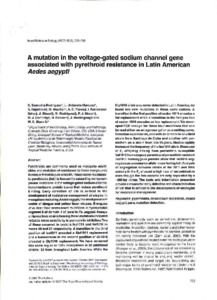A mutation in the voltage-gated sodium channel gene associated with pyrethroid resistance in Latin American Aedes aegypti
Saavedra Rodríguez, Karla Lizet y Urdaneta Marquez, Ludmel y Rajatileka, S. y Flores Suárez, Adriana Elizabeth y Fernández Salas, Ildefonso y Bisset, J. y Rodríguez, Mario Henry y Mccall, P. J. y Donnelly, M. J. y Ranson, Hilary y Hemingway, Janet y Black, William C.
(2007)
A mutation in the voltage-gated sodium channel gene associated with pyrethroid resistance in Latin American Aedes aegypti.
Insect molecular biology, 16 (6).
pp. 785-798.
![[img]](http://eprints.uanl.mx/1811/1.hassmallThumbnailVersion/A_mutation_in_the_voltage_gated_sodium_channel_gene_associated_with_pyrethroid_resistance_in_Latin_American_Aedes_aegypti.pdf)  Vista previa |
|
PDF
A_mutation_in_the_voltage_gated_sodium_channel_gene_associated_with_pyrethroid_resistance_in_Latin_American_Aedes_aegypti.pdf
Download (1MB)
| Vista previa
|
Resumen
Pyrethroids are commonly used as mosquito adulticides and evolution of resistance to these compounds is a major threat to public health. 'Knockdown resistance' to pyrethroids (kdr) is frequently caused by nonsynonymous mutations in the voltage-gated sodium channel transmembrane protein (para) that reduce pyrethroid binding. Early detection of kdr is critical to the development of resistance management strategies in mosquitoes including Aedes aegypti, the most prevalent vector of dengue and yellow fever viruses. Brengues et al. described seven novel mutations in hydrophobic segment 6 of domain II of para in Ae. aegypti. Assays on larvae from strains bearing these mutations indicated reduced nerve sensitivity to permethrin inhibition. Two of these occurred in codons Iso1011 and Val1016 in exons 20 and 21 respectively. A transition in the third position of Iso1011 encoded a Met1011 replacement and a transversion in the second position of Val1016 encoded a Gly1016 replacement. We have screened this same region in 1318 mosquitoes in 32 additional strains; 30 from throughout Latin America. While the Gly1016 allele was never detected in Latin America, we found two new mutations in these same codons. A transition in the first position of codon 1011 encodes a Val replacement while a transition in the first position of codon 1016 encodes an Iso replacement. We developed PCR assays for these four mutations that can be read either on an agarose gel or as a melting curve. Selection experiments, one with deltamethrin on a field strain from Santiago de Cuba and another with permethrin on a strain from Isla Mujeres, Mexico rapidly increased the frequency of the Iso1016 allele. Bioassays of F3 offspring arising from permethrin susceptible Val1016 homozygous parents and permethrin resistant Iso1016 homozygous parents show that Iso1016 segregates as a recessive allele in conferring kdr. Analysis of segregation between alleles at the 1011 and 1016 codons in the F3 showed a high rate of recombination even though the two codons are only separated by a ~250 bp intron. The tools and information presented provide a means for early detection and characterization of kdr that is critical to the development of strategies for resistance management.
| Tipo de elemento: |
Article
|
| Materias: |
Q Ciencia > Q Ciencias en General |
| Divisiones: |
Ciencias Biológicas |
| Usuario depositante: |
Admin Eprints
|
| Creadores: |
| Creador | Email | ORCID |
|---|
| Saavedra Rodríguez, Karla Lizet | NO ESPECIFICADO | NO ESPECIFICADO | | Urdaneta Marquez, Ludmel | NO ESPECIFICADO | NO ESPECIFICADO | | Rajatileka, S. | NO ESPECIFICADO | NO ESPECIFICADO | | Flores Suárez, Adriana Elizabeth | NO ESPECIFICADO | NO ESPECIFICADO | | Fernández Salas, Ildefonso | ifernand1@hotmail.com | NO ESPECIFICADO | | Bisset, J. | NO ESPECIFICADO | NO ESPECIFICADO | | Rodríguez, Mario Henry | NO ESPECIFICADO | NO ESPECIFICADO | | Mccall, P. J. | NO ESPECIFICADO | NO ESPECIFICADO | | Donnelly, M. J. | NO ESPECIFICADO | NO ESPECIFICADO | | Ranson, Hilary | NO ESPECIFICADO | NO ESPECIFICADO | | Hemingway, Janet | NO ESPECIFICADO | NO ESPECIFICADO | | Black, William C. | NO ESPECIFICADO | NO ESPECIFICADO |
|
| Fecha del depósito: |
25 Ene 2011 21:56 |
| Última modificación: |
09 Jul 2025 18:42 |
| URI: |
http://eprints.uanl.mx/id/eprint/1811 |
Actions (login required)
 |
Ver elemento |


 Descargar estadísticas
Descargar estadísticas Descargar estadísticas
Descargar estadísticas

